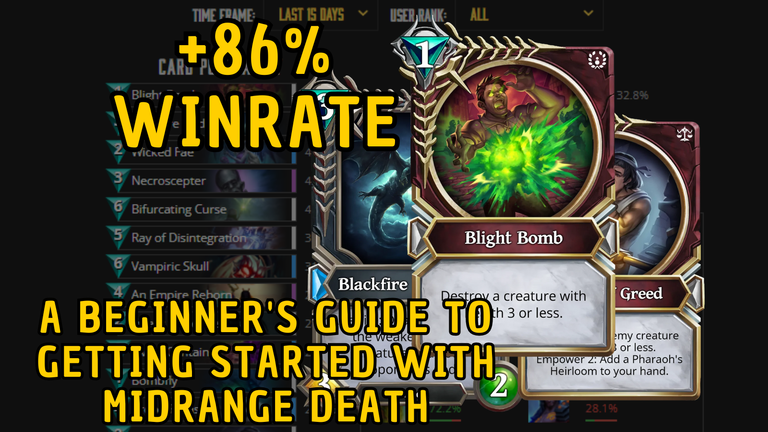
English Version
Midrange Death deck as quickly as possible.If I were starting today and hadn't learned everything I know from the #GodsOnChain community, I would really try to get a
If you're starting out or are already at intermediate levels in Gods Unchained and want a solid deck to climb the ranks, Midrange Death might be one of the best choices. This archetype balances efficient removals, constant healing, and a well-structured win condition. Moreover, it performs very well against aggressive decks, which are quite common in lower ranks.
In this guide, I’ll explain how Midrange Death works, which cards are essential, how it fares against the main beginner decks up to a certain rank, and how you can play it as efficiently as possible.

source
But why Midrange Death?
Midrange Death is a deck that combines board control with increasing pressure throughout the game. It’s not as explosive as Aggro Death, but it’s also not as passive as Control Death. Instead, it focuses on surviving the early game while wearing down the opponent until it gains a dominant position in the mid-game and then finishes with its strongest creature.
The main characteristics of the deck are:
- Efficient use of Afterlife – Many creatures have effects upon dying, generating constant value.
- Control with Removals – The deck has powerful tools to clear the enemy board.
- Sustain with Leech and Healing – Keeps the player alive against aggressive decks.
- Solid win conditions – Wins with strong creatures and attrition effects throughout the game.
If you enjoy a balanced playstyle, with a mix of control and offense, it’s certainly a great choice to start with.
I’ve shared some insights on using Death Decks i used to enjoy summoning Zombies while maintaining board control, in addition to getting a significant amount of healing due to their low cost.
Thanks Again Weekend Ranked for Friday's Stress
GODS UNCHAINED: Soul Burn + Aggro Frenzied Creatures
GODS UNCHAINED: Zombies Against Deception Cards Seems Like a Bad Choice
Gods Unchained: Discard the Card REBUILD DIFFERENTLY
And many others, you can visit my profile on PeakD and check out all my posts.
Now let's talk about the most important cards in this deck. Recently, the three most popular cards in Midrange Death, according to GuDeck, have been:
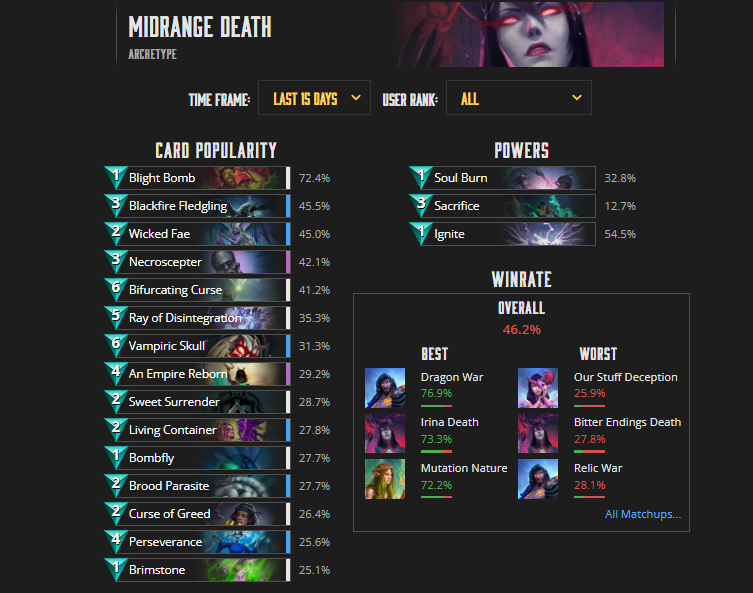
Blight Bomb (72%)
This 1-mana removal spell is essential for maintaining board control and dealing with early threats, especially against aggressive decks like Zoo War and Zoo Light. Since it only costs 1 mana, you can remove small creatures and maintain board advantage from the start. I’m not surprised this card is in the top position, but I think Necroscepter could easily take its spot (I’ll talk more about this later).
Blackfire Fledgling (45%)
Great stats (3/2) for its Afterlife ability after being eliminated, it deals 3 damage to the weakest enemy creature and also 3 damage to the opponent’s God. This means you can remove two creatures in one turn: attack the first with this creature and execute the second with its ability.
Wicked Fae (45%)
I don’t use this creature much, but I can say it is mainly valued for its control potential. It eliminates a 1-health creature as soon as it’s played and then summons an *Impling with (1/1) stats.
However, I would say that Necroscepter should be among the top three most-used cards, as I see this relic in almost every Midrange Death match or other Death compositions. Necroscepter provides a steady flow of zombies, helping with board control and applying pressure. If you're Frenzied, you can summon two in the same turn.
Midrange Death can be played with different God Powers, depending on strategy and matchup.
While Ignite is the most chosen ability in matches, Sacrifice is the least favored, perhaps because it’s too slow and even damages your God. I really don’t like this power.
- Ignite – Adds +1 Burn to a target creature, ideal for maintaining control and removal in most matches.
- Soul Burn – Deals damage to both Gods, efficient for Frenzied-based compositions.
- Sacrifice – Possibly for a Casino-style deck? Hard to explain.
A highlighted low-cost composition was shared on GuDecks you can copy it using the code below the image capture.
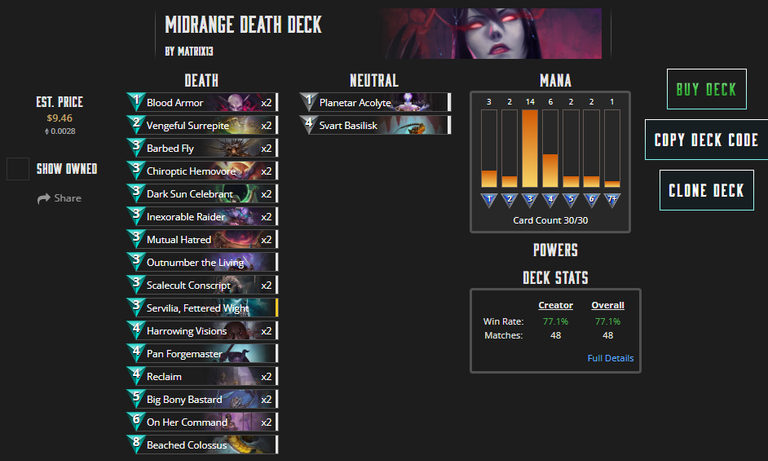
GU_1_1_IBKIBKICCKCAKCAIBTIBTKDEKDEKCCKCCIBOIBOIBaIBaIAGNAUNAUQAeIBUIBUIBLKCDKCDCBqKCHKCHKCFKCFKDN
Midrange Death vs Other "Starter Decks"
Now, let’s analyze how this deck performs against the most common archetypes in beginner/intermediate ranks. Data sourced from Meta Matchups, which you can check for yourself.
Midrange Death has an advantage over Zoo War, as this deck relies on quickly filling the board, but Midrange Death has efficient removals and healing. Just maintaining board order can turn the game in your favor, and prioritizing Blight Bomb to quickly remove small creatures or frontlines is essential.
Against Amazon Nature, which you'll likely encounter often, Midrange Death has a slight advantage since Nature relies on buffs and ramp but struggles against Death’s removals. Avoid leaving too many creatures on the board simultaneously, as Nature can clear them with spells like Lightning Strike. It’s amazing how even an Amazon-focused deck can still include an AOE removal.
Against Zoo Light, Midrange Death has a strong advantage, as Zoo Light buffs small creatures, but Death can easily remove them. Necroscepter is crucial in this matchup, as it keeps creatures on the board and absorbs damage.
Against Aggro Death, which can sometimes feel similar to Midrange, the matchup is balanced and depends on who gets the better starting hand. If Aggro Death pressures quickly, it can be hard to recover. Otherwise, Midrange Death’s healing and board control tend to prevail.
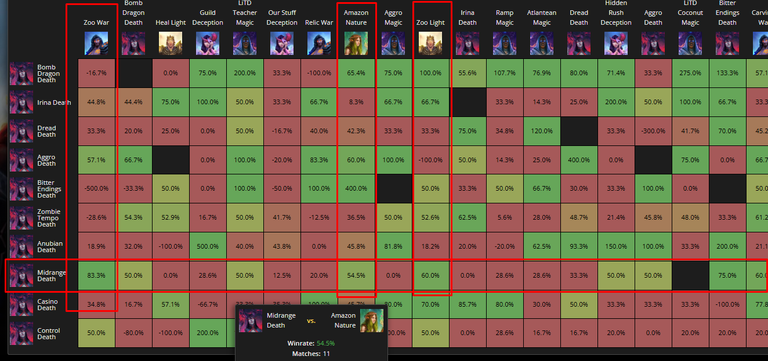
Tips from a Death Deck Player
- Use removals wisely – Don’t waste a Blight Bomb too early.
- Don’t fear losing life early – Your deck has enough healing to recover.
- Avoid unnecessary board flooding – Play cautiously against decks with AOE removal.
- Maximize Necroscepter’s value – If possible, protect it to generate more zombies.
Midrange Death is one of the best decks for beginners and intermediates because of its consistency and versatility. It does very well against aggro decks, has good win conditions and doesn't rely on expensive cards to be effective.
If you want a deck that will help you rank up while you learn important game mechanics, Midrange Death is an excellent choice.
Credits for screenshots taken from Gods Unchained and GuDecks
https://godsunchained.com/
https://gudecks.com/
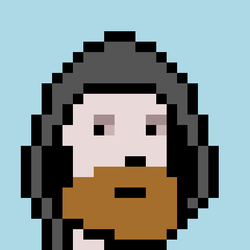
About the Author
A Web3 Gaming enthusiast. He dedicates part of his time to Play-to-Earn games and the ecosystem they integrate. A weekly author sharing various posts about this through the Hive Blockchain. If you’re not part of it yet, consider registering via my Referral Link to follow all my content shared here.

Versão em Português
Midrange Death o mais rápido possivel.Se eu estivesse começando hoje, e não tivesse aprendido tudo que sei com a comunidade #GodsOnChain, eu realmente tentaria conseguir um deck
Se você está começando ou já está nos níveis intermediários de Gods Unchained e quer um deck sólido para subir de rank, o Midrange Death pode ser uma das melhores escolhas. Esse arquétipo equilibra remoções eficientes, cura constante e uma condição de vitória bem estruturada. Além disso, ele se sai muito bem contra decks agressivos, que são bastante comuns em ranks mais baixos.
Neste guia, vou explicar como o Midrange Death funciona, quais cartas são essenciais, como ele se sai contra os principais decks iniciais até certo rank e como você pode jogá-lo da maneira mais eficiente possível

source
Mas porque Midrange Death?
O Midrange Death é um deck que combina controle de campo com uma pressão crescente ao longo da partida. Ele não é tão explosivo quanto um Aggro Death, mas também não é tão passivo quanto um Control Death. Em vez disso, ele se concentra em sobreviver ao início do jogo, enquanto desgasta o oponente até conseguir uma posição dominante no meio da partida e então finalizar com sua melhor criatura.
As principais características do deck são:
Uso eficiente de Afterlife – Muitas criaturas têm efeitos ao morrer, o que gera valor constante.
Controle com Remoções – O deck conta com ferramentas poderosas para limpar o tabuleiro inimigo.
Sustentação com Leech e Cura – Mantém o jogador vivo contra decks agressivos.
Condições de vitória sólidas – Ganha com criaturas fortes e efeitos de desgaste ao longo do jogo.
Se você curte um estilo de jogo equilibrado, com uma mistura de controle e ataque, certamente é uma ótima escolha para começar.
Eu tenho compartilhado algumas coisas referentes utilizando Death Decks, eu gostava bastante das invocações de Zombies enquanto eles mantinham o controle no tabuleiro, além de conseguir me promover uma cura considerável, baseado no seu baixo custo.
Thanks Again Weekend Ranked for Friday's Stress
GODS UNCHAINED: Soul Burn + Aggro Frenzied Creatures
GODS UNCHAINED: Zombies Against Deception Cards Seems Like a Bad Choice
Gods Unchained: Discard the Card REBUILD DIFFERENTLY
E muitos outros, você pode visitar meu perfil em PeakD e ver todas minhas postagens.
Agora vamos falar sobre as cartas mais importantes desse deck. Recentemente, as três cartas mais populares no Midrange Death têm sido seguindo informações do GuDeck.

Blight Bomb (72%)
Essa carta de remoção de apenas 1 custo de mana é essencial para manter o controle do tabuleiro e eliminar algumas preocupações iniciais, principalmente contra decks agressivos como Zoo War e Zoo Light. Como é um feitiço de apenas 1 mana, você pode remover criaturas pequenas e manter a vantagem de campo desde o início do jogo. Não me espanta essa carta estar em primeiro posição, mas eu acho que poderia facilmente chutar sobre Necroscepeter (falo sobre isso mais a frente).
Blackfire Fledgling (45%)
Ótimos atributos (3/2) para sua habilidade de Afterlife, após ser eliminado ele ira causar 3 de ataque na criatura inimiga mais fraca, e também causar 3 de ataque no Deus rival. Ou seja, você pode remover duas criaturas em um turno só, atacando o primeiro com essa criatura, e executando o segundo com sua habilidade.
Wicked Fae (45%)
Eu não tenho muita utilização com essa criatura, mas posso dizer também que ele é mais levado em consideração pelo controle que ele consegue ter. Ele elimina uma criatura com 1 de vida assim que é lançado no tabuleiro, e então invoca um *Impling com os atributos (1/1).
No entanto, eu diria que Necroscepter deveria estar entre as três cartas mais utilizadas, pois vejo essa relíquia em quase todas as partidas de Midrange Death ou outras composições Death. O Necroscepter fornece um fluxo constante de zumbis, ajudando no controle de campo e pressionando o oponente. Isso é, se você estiver Frenzied, você consegue invocar 2 no mesmo turno.
O Midrange Death pode ser jogado com diferentes God Powers, dependendo da estratégia e do matchup.
Enquanto a habilidade de poder *Ignite é a mais escolhida para as partidas, Sacrifice fica em último lugar, talvez por ser muito lento e ainda causar dano no seu Deus. Eu realmente não gosto desse poder.
Ignite - Adicionando +1 Burn a uma criatura alvo, ideal para manter o controle e remoção nas maiorias das partidas.
Soul Burn - Causar dano em ambos os Deuses, eficiente para composições que se aproveitam de Frenzied.
Sacrifice - Possivelmente para o Cassino? Difícil explicar sobre isso.
A uma composição em destaque de baixo custo compartilhada em GuDecks, você pode copiar isso através do código logo abaixo da captura de imagem.

GU_1_1_IBKIBKICCKCAKCAIBTIBTKDEKDEKCCKCCIBOIBOIBaIBaIAGNAUNAUQAeIBUIBUIBLKCDKCDCBqKCHKCHKCFKCFKDN
Midrange Death vs Outros Decks "Iniciais"
Agora, vamos analisar como esse deck se sai contra os arquétipos mais comuns nos ranks iniciante/intermediário. Informações retiradas através Meta Matchups, você pode conferir por si também.
Midrange Death tem vantagem contra Zoo War, pois este depende de encher o tabuleiro rapidamente, mas Midrange Death possui remoções eficientes e cura. Apenas manter a ordem no tabuleiro pode virar o jogo a seu favor, e é essencial priorizar Blight Bomb para remover criaturas pequenas rapidamente ou linhas de frentes.
Contra Amazon Nature que provavelmente você vai encontrar bastante, Midrange Death leva uma leve vantagem, já que Nature depende de buffs e ramp, mas tem dificuldades para lidar com as remoções de Death. É importante evitar deixar muitas criaturas no campo ao mesmo tempo, pois Nature pode limpá-las com feitiços como Lightning Strike. É incrivel como mesmo um Deck focado em Amazonas, eles conseguem adicionar uma remoção AOE nele.
No confronto contra Zoo Light, Midrange Death tem uma boa vantagem, já que Zoo Light utiliza buffs para fortalecer criaturas pequenas, mas Death pode removê-las facilmente. Necroscepter é uma carta essencial nesse duelo, pois mantém criaturas no campo e absorve dano.
Já contra Aggro Death, que muitas vezes pode parecer semelhante ao Midrange, o matchup é equilibrado e depende da melhor mão inicial. Se o Aggro Death conseguir pressionar rapidamente, pode ser difícil recuperar. Caso contrário, a cura e o controle de campo de Midrange Death tendem a prevalecer.

Dicas de um jogador de Death Decks
Use suas remoções com sabedoria – Evite gastar uma Blight Bomb cedo demais; espere para remover criaturas que realmente ameaçam seu controle do jogo.
Não tenha medo de perder vida no início – Seu deck tem cura suficiente para recuperar depois.
Evite encher o tabuleiro desnecessariamente – Alguns decks possuem remoções em área, então jogue com cautela.
Maximize o valor de Necroscepter – Se possível, proteja-o para obter o máximo de valor com os zumbis.
O Midrange Death é um dos melhores decks para iniciantes e intermediários por causa de sua consistência e versatilidade. Ele se sai muito bem contra decks aggro, tem boas condições de vitória e não depende de cartas caras para ser eficiente.
Se você quer um deck que te ajude a subir de rank enquanto aprende mecânicas importantes do jogo, Midrange Death é uma escolha excelente.
- Créditos de capturas de imagens retiradas do jogo Gods Unchained e de GuDecks
https://godsunchained.com/
https://gudecks.com/

Sobre o Autor
Apreciador de Web3 Gaming. Entusiasta e dedica um pouco do seu tempo a jogos no estilo Play-to-Earn e pelo ecossistema que eles integram. Autor semanal publicando diversas postagens referente a isso através da Hive Blockchain. Se você ainda não faz parte disso, considere se registrar através do meu Link de Referencia para acompanhar todo meu conteúdo compartilhado aqui.

The rewards earned on this comment will go directly to the people( @ifhy ) sharing the post on Reddit as long as they are registered with @poshtoken. Sign up at https://hiveposh.com. Otherwise, rewards go to the author of the blog post.
A word of caution regarding archetypes in GU Decks: the archetype rules are set by a player (jazus) on behalf of the GU Decks team and they are in dire need of updating. On top of that, if you add Necrocepter it's very likely a 'midrange deck' without many Dragons or Dreads would be classified immediately as 'Zombies'. I would look at all archetype designations with a critical eye. Many are almost meaningless.
That deck you shared from matrix13 has some really questionable choices, like Scalecult Conscript without any Dread generation and On Her Command, which is a super expensive single-target removal with an upside that is very difficult to hit with the only 1-mana Anubians coming from Heirlooms, which frankly get removed 95% of the times during the opponent's turn. The card is not played in a full-on Anubian / Heirloom deck, so in a deck like this it makes even less sense. Harrowing Visions and Reclaim are 2 expensive draw cards, Death has much better options than these. A deck like this usually cannot afford to spend 1 turn just drawing cards and not putting any meaningful pressure on the board. Blood Armor is almost useless and Blight Bomb would be a much better card for that 1 mana slot. Curse of Greed is much better than Vengeful Surrepite, Bronze Servant (Anubian!) instead of Basilisk, etc. There are some obvious substitutions to be made to that list and even then I'm not sure it would compete in Solar+.
Regarding the deck in question, it has a winrate of +50%, so it seems to be working that way, I don't think everything has to be the same, if it's working that's fine
Delegate your HP to the hive-br.voter account and earn Hive daily!
🔹 Follow our Curation Trail and don't miss voting! 🔹
Your post was manually curated by @shiftrox.Bzzt! @ifhy, esse guia é tudo! Meu bee-ílico é perfeito para Midrange Death, eu só faço isso! #hivebr
AI generated content
Obrigado por promover a comunidade Hive-BR em suas postagens.
Vamos seguir fortalecendo a Hive
Hi, I like your death deck with "Servilia, Fettered Wight" and "Beached Colossus", nice post my friend.👍👍👍
Thank you for your comment
I played GodsUnchained about a year ago and right know I am thinking about playing it again. Your deck guide will help me, if I start playing again. Thanks! :)